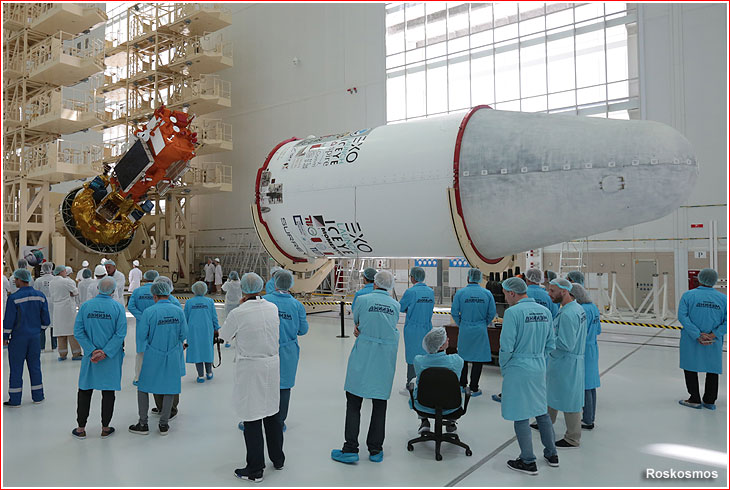For humans and satellites alike, making a living is space is hard. First, there's the problem of surviving the brief but energetic and failure-prone ride there, after which you get to alternately roast and freeze as you zip around the planet at 20 times the speed of sound. The latter fact is made all the more dangerous by the swarm of space debris, both natural and man-made, that whizzes away up there along with you, waiting to cause an accident.
One such accident has apparently led to the early demise of a Russian weather satellite. Just a few months after launch, Meteor-M 2-2 suffered a sudden orbital anomaly (link to Russian story; English translation). Analysis of the data makes it pretty clear what happened: the satellite was struck by something, and despite some ground-controller heroics which appear to have stabilized the spacecraft, the odds are that Meteor-M 2-2 will eventually succumb to its wounds.
Weather Watchers
To call the Meteor-M series of satellites unlucky is something of an understatement. Originally conceived as a four-satellite constellation, the birds were to be equipped with the latest in imaging and sensing instruments and launched into sun-synchronous polar orbits. They would afford Russia scientists complete coverage of the vast country every couple of days, with special emphasis on monitoring conditions in the Arctic regions.
Original plans called for a series of satellites called Meteor-3M to be launched between 1998 and 2000, but for unknown reasons the satellites were never built. The plan morphed into the Meteor-M series, which aimed to be in service by 2010. The first satellite, Meteor-M1, was launched in 2009, but spent years in an "experimental operation" mode before being listed as in full service. After only two years of nominal operation, instruments began to fail, including an X-band radar designed to monitor sea ice and a critical infrared imager. In 2014, the satellite's attitude control system failed too, rendering the entire spacecraft useless.

To address some of the instrument deficiencies, an improved series of satellites, the Meteor-M2 series, was designed. The first of these, Meteor-M 2-1, made it to the launch pad at Vostochny Cosmodrome in November of 2017, but didn't make it much further. An error in the navigation system programming led the upper stage to fire its engines when it was pointed the wrong way, dropping the satellite payload into the North Atlantic.
Meteor-M 2-2 fared much better in its July 2019 launch. The 2,900 kg spacecraft, along with 33 other small satellite payloads, rode to orbit successfully aboard a Soyuz-2-1b. The programming errors that doomed its predecessor had been corrected, and Meteor-M 2-2 entered its assigned orbit and began returning data. It seemed like the satellite was on its way to a long and useful career as a weather watcher.
Trouble Upstairs
The textbook operations of Meteor-M 2-2 wouldn't last long, though, and as is often the case, an amateur radio operator was among the first to notice. Dmitry Pashkov (R4UAB), a satellite monitoring fan, had been capturing images from weather satellites for years. But when he tried to find Meteor-M 2-2 on December 18, 2019, all he got was dead air. It seemed like the satellite was gone, and once he announced his findings, it wasn't long before other satellite watchers pieced together a story, one that would eventually be confirmed by Roscosmos, the Russian space agency.
Based on the data, it appears that Meteor-M 2-2 was struck by a micrometeoroid – either a natural chunk of space rock or some piece of man-made debris. The SUV-sized satellite was sent spinning violently out of control by the impact. It immediately put itself into a safe mode to protect its instrumentation and give ground controllers time to regain control, which they eventually did. Subsequent analysis of the orbital data revealed that the satellite had also lost two kilometers of orbital altitude immediately after the impact.

Such a violent disruption of a satellite as big as Meteor-M 2-2 would imply a large, very energetic collision. But that would likely break the satellite into multiple pieces, and there's no evidence that anything like that happened. That means the impactor was small, which appears at odds with the outsized effect it had on the spacecraft. That leaves operators considering whether the impact penetrated a pressurized part of the satellite's hull. That could explain the drastic change in attitude and altitude.
Unfortunately, it could also mean the end of Meteor-M 2-2's mission. Many of the instruments aboard the satellite require constant temperatures to work, and the electronics controlling the bird may now be exposed to the vacuum of space. Roscosmos has regained control of the spacecraft and damped down its spin, and there are even reports that an X-band signal from the satellite has been detected.
With a depressurized hull, the spacecraft is likely doomed to follow in the sad footsteps of its predecessors. It's yet another in a long string of failed or marginal weather satellites, the passing of each which is mourned by the satellite monitoring community. There are still plenty of satellites up there providing realtime weather and climate imagery, but the likely loss of Meteor-M 2-2 shows just how dangerous it can be up there.
via https://ift.tt/2SwZQDk





2 Comments
I found that site very usefull and this survey is very cirious, I ' ve never seen a blog that demand a survey for this actions, very curious... oet online coaching
ReplyDeleteI found that site very usefull and this survey is very cirious, I ' ve never seen a blog that demand a survey for this actions, very curious... oet online coaching
ReplyDelete